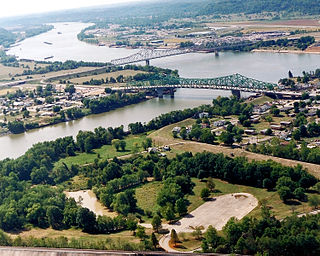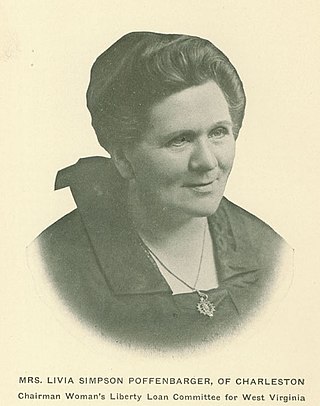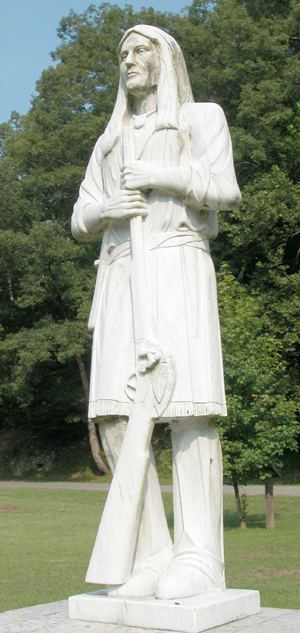
The American Revolutionary War, also known as the Revolutionary War or American War of Independence, was the military conflict of the American Revolution in which American Patriot forces largely under George Washington's command defeated the British, resulting in the Treaty of Paris (1783) recognizing the independence and sovereignty of the United States. Fighting began on April 19, 1775, at the Battles of Lexington and Concord. The war was formalized and intensified following passage of the Lee Resolution, which asserted that the Thirteen Colonies were "free and independent states", by the Second Continental Congress in Philadelphia on July 2, 1776, and the unanimous ratification of the Declaration of Independence two days later, on July 4, 1776.

Mason County is a county in the U.S. state of West Virginia. As of the 2020 census, the population was 25,453. Its county seat and largest city is Point Pleasant. The county was founded in 1804 and named for George Mason, delegate to the U.S. Constitutional Convention. Before the Civil War, the county was in the State of Virginia.

Point Pleasant is a city in and the county seat of Mason County, West Virginia, United States, at the confluence of the Ohio and Kanawha Rivers. The population was 4,101 at the 2020 census. It is the principal city of the Point Pleasant micropolitan area extending into Ohio. The town is best known for the Mothman, a purported humanoid creature reportedly sighted in the area that has become a part of West Virginia folklore.

Lord Dunmore's War, also known as Dunmore's War, was a brief conflict in fall 1774 between the British Colony of Virginia and the Shawnee and Mingo in the trans-Appalachian region of the colony south of the Ohio River. Broadly, the war included events between May and October 1774. The governor of Virginia during the conflict was John Murray, 4th Earl of Dunmore, who in May 1774, asked the House of Burgesses to declare a state of war with the Indians and call out the Virginia militia.

The Battle of Point Pleasant, also known as the Battle of Kanawha and the Battle of Great Kanawha, was the only major action of Dunmore's War. It was fought on October 10, 1774, between the Virginia militia and Shawnee and Mingo warriors. Along the Ohio River near modern-day Point Pleasant, West Virginia, forces under the Shawnee chief Cornstalk attacked Virginia militiamen under Colonel Andrew Lewis, hoping to halt Lewis's advance into the Ohio Valley. After a long and furious battle, Cornstalk retreated. After the battle, the Virginians, along with a second force led by Lord Dunmore, the Royal Governor of Virginia, marched into the Ohio Valley and compelled Cornstalk to agree to a treaty, which ended the war.

Cornstalk was a Shawnee leader in the Ohio Country in the 1760s and 1770s. His name in the Shawnee language was Hokoleskwa. Little is known about his early life. He may have been born in the Province of Pennsylvania. In 1763, he reportedly led a raid against British American colonists in Pontiac's War. He first appears in historical documents in 1764, when he was one of the hostages surrendered to the British as part of the peace negotiations ending Pontiac's War.
Pickaway Plains is a wide area of rolling hills beginning about 3 miles south of Circleville, Ohio, and extending several miles to the north and south. This geological area was formed by sand and gravel deposited by melting water from the last glacier to retreat from the region during the Ice Age. During the time of inhabitation by the Shawnee, the Pickaway Plains were covered by prairie vegetation, mainly grasses.

The western theater of the American Revolutionary War (1775–1783) was the area of conflict west of the Appalachian Mountains, the region which became the Northwest Territory of the United States as well as what would become the states of Arkansas, Kentucky, Louisiana, Missouri, and Tennessee. The western war was fought between American Indians with their British allies in Detroit, and American settlers south and east of the Ohio River, and also the Spanish as allies of the latter.

Andrew Lewis was an Irish-born American surveyor, military officer and politician. Born in County Donegal, he moved with his family to the British colony of Virginia at a young age. A colonel in the Virginia militia during the French and Indian War, and brigadier general in the American Revolutionary War, his most famous victory was the Battle of Point Pleasant in Dunmore's War in 1774, although he also drove Lord Dunmore's forces from Norfolk and Gwynn's Island in 1776. He also helped found Liberty Hall in 1776.

Samuel Hammond was a lieutenant colonel during the American Revolutionary War, governor and leader in the Louisiana and Missouri Territories, and United States Representative from Georgia in the 8th United States Congress.

Captain Michael Cresap was a noted frontiersman born in Maryland, in what is now the United States.

Fort Randolph was an American Revolutionary War fort which stood at the confluence of the Ohio and Kanawha Rivers, on the site of present-day Point Pleasant, West Virginia, United States.
Anne Bailey was a British-born American story teller and frontier scout who served in the fights of the American Revolutionary War and the Northwest Indian War. Her single-person ride in search of an urgently needed powder supply for the endangered Clendenin's Settlement was used as the template for Charles Robb's 1861 poem "Anne Bailey's Ride". She is known as the Heroine of the Kanawha Valley.
Colonel John Stuart was a Revolutionary War commander and pioneering western Virginia settler. A veteran of the Battle of Point Pleasant (1774), he surveyed and settled the Greenbrier Valley and is known locally as the "Father of Greenbrier County". Owing to his Memoir of Indian Wars and Other Occurrences, written in 1799, he has been called "the most important chronicler of pioneer history in southern West Virginia".

Olivia Nye Simpson Poffenbarger was an American newspaper owner/editor, historian, social activist, civic leader, and Republican politician in West Virginia.

Sampson Mathews was an American merchant, soldier, and legislator in the colony of Virginia.
Captain Mathew Arbuckle Sr., was a pioneering hunter and trapper of western Virginia and the Ohio territory. He is considered likely to have been the first white person to travel through Virginia all the way to the Ohio River, other than as a prisoner of the Indians. This trapping and trading trip may have occurred around 1764.

Lewis Magisterial District is one of ten magisterial districts in Mason County, West Virginia, United States. The district was originally established as a civil township in 1863, and converted into a magisterial district in 1872. In 2020, Robinson District was home to 5,635 people.
Leonard Morris was an early American pioneer, soldier, and lawman, who was one of the founders of Charleston, West Virginia in 1788., and named as a trustee of Charleston when the town was incorporated by the Virginia House of Delegates in 1794. Leonard is the brother of Virginia House Representative William Morris, Henry Morris, Captain John Morris, and uncle of US Congressman Calvary Morris, and Bishop Thomas Asbury Morris

Logan's War was a 1774 retribution campaign or "mourning war" led by Mingo leader Logan in retaliation for the Yellow Creek massacre. Lord Dunmore's War was a direct result of Logan's campaign.

















